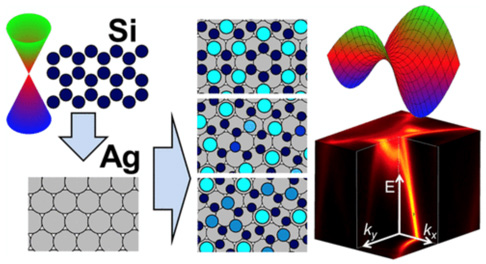 We have compared the electronic structure of (4×4), (√13×√13) R 13.9° and (2√3×2√3) R 30° silicene monolayers on Ag(111) by means of angle–resolved photoemission spectroscopy and first–principles calculations. We have found that all phases display similar Ag–derived interface states and s bands weakly perturbed by the substrate interaction. Intense spectral features, including those previously attributed to s band emission from the (2√3×2√3) R 30° structure, are found to originate from umklapp replicas of the Ag interface state and Ag sp–bulk bands. All the examined silicene allotropes do not display the characteristic Dirac cones of free–standing silicene, proving that the p bands are strongly modified by the interaction with the substrate bands independently of the structural detail of the allotrope.
We have compared the electronic structure of (4×4), (√13×√13) R 13.9° and (2√3×2√3) R 30° silicene monolayers on Ag(111) by means of angle–resolved photoemission spectroscopy and first–principles calculations. We have found that all phases display similar Ag–derived interface states and s bands weakly perturbed by the substrate interaction. Intense spectral features, including those previously attributed to s band emission from the (2√3×2√3) R 30° structure, are found to originate from umklapp replicas of the Ag interface state and Ag sp–bulk bands. All the examined silicene allotropes do not display the characteristic Dirac cones of free–standing silicene, proving that the p bands are strongly modified by the interaction with the substrate bands independently of the structural detail of the allotrope.
Contact person: Polina Sheverdyaeva, ISM Trieste
